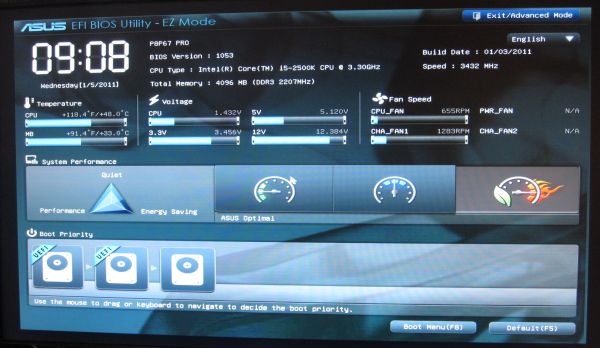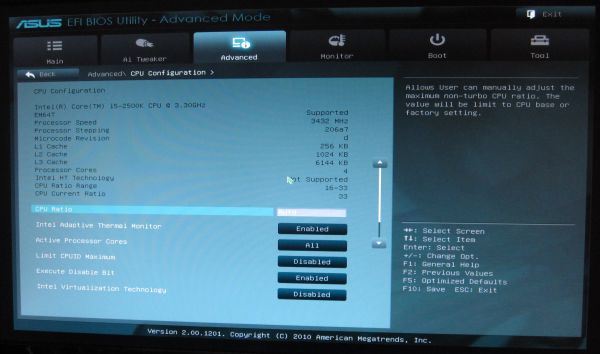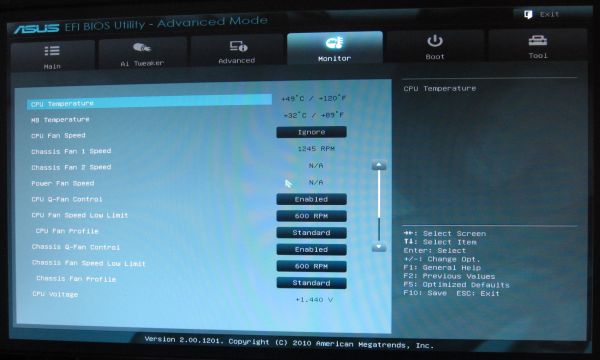The Battle of the P67 Boards - ASUS vs. Gigabyte at $190
by Ian Cutress on January 20, 2011 4:15 PM EST- Posted in
- Motherboards
- Gigabyte
- Asus
- P67
ASUS bring a lot of innovation to the UEFI table over what I have seen from other vendors. The implementation of EZ mode (‘easy’ mode, for us Brits that pronounce that letter ‘zed’) gives the screen below on first entering the UEFI. At a glance, it gives vital motherboard information – CPU, speed, memory, temperatures, voltages, fan speeds, and boot order. The boot order is a great addition, allowing the user to drag-click the order they want. Also available is the three performance options – low power, standard, and performance.
By clicking onto the advanced mode, we get a more BIOS-esque representation of all the motherboard features. The Ai tweaker provides all the overclocking tools we would expect, and more than you find in the Ai Suite in the OS. Features use either a text box for typing values, or a selection box for preset values. The user can utilise the mouse or the keyboard for either task.
Elements such as enhanced sleep states appear under the Advanced CPU Configuration menu, where cores and ratios can be determined. In the Onboard Devices section, if you are not using the Marvell SATA ports, it is advised that this be switched off, to increase boot time by 1-2 seconds.
Fan controls are found in the Monitor tab, where a low limit fan RPM can be given and fan control can be switched between standard/silent/turbo/manual. In manual mode, you can adjust the upper and lower temperature of the fan and at which percentage speed it should run at those temperatures.
Users can specify advanced mode to be shown as soon as the UEFI is selected, and ten UEFI profiles can be saved. The UEFI can also be updated through the Tools tab if the latest file is supplied on a USB drive and plugged in before the ‘update’ option is chosen.
Overclocking
Overclocking on the P8P67 Pro was easy. The UEFI EZ mode offers a performance mode option, which on selecting, enabled the XMP profile of the memory, applied a 103 BCLK, and set the turbo limit to 42x, giving a 4.33 GHz overclock.
As the Ai Suite offers the ‘Auto Tuning’ option, I selected this in the OS and let the program do its thing. After a couple of reboots, and a BSOD, the OS booted into a screen showing a 43x multiplier at 103.5 BCLK (4.45 GHz), and attempted a series of stability tests, slowing increasing the BCLK by 0.5 every 30 seconds. At 105.5 BCLK, a BSOD screen appeared and seemed to crash halfway through, requiring me to reset the system physically. On the next boot, it was stated that the 43x103.5 overclock was applied and now usable. This system is likeable as it promises to adjust depending on how overclockable the processor is.
The downside is that the Ai Suite is quite conservative. I kept with the 103.5 BCLK and went into the UEFI. In advanced mode, adjusting the turbo ratio by one each time and rebooting led to a 46x multiplier (4.76 GHz) successfully passing stability tests. For 47x multiplier (4.86 GHz), I increased the PLL to 1.9V, CPU VCore to 1.42 V, and adjusted the short/long power limits to 150 W/130 W to get a successful stability test pass. This automatically set the memory to a command rate of 3T, so was set back to 1T manually. The 48x multiplier did not boot at this level, and I was not prepared to up the VCore or power limits any more. A 4.86 GHz overclock is very respectable!
At 4.86 GHz (47% OC over 3.3 GHz/non turbo/multithreaded, 31% OC over 3.7 GHz/turbo/single-threaded), the 3D Movement benchmark was run. In single thread mode, a score of 148.92 was achieved, a 31% increase. In multi-threaded mode, a score of 477.60 was achieved, a 37% increase.




















137 Comments
View All Comments
IanCutress - Thursday, January 20, 2011 - link
Long term usability isn't something that's easily tested. Sleep and hibernate is simple to test, but leaving the board on for a week? We unfortunately a) do not have enough hardware to keep the mu;tiples of same test bed and test other products at the same time, and b) if something did go wrong after a long sleep state, how long it would take to get in a different BIOS and re-run the test, or if a new BIOS had been released during the test, the test would have to be restarted. It's not a case of this being ignored by review sites, it's just not an applicable use of time, effort, and sustainability. If this is a major concern to you, then I'd suggest holding back until the next revisions of these boards hit the shelves - by that point, issues would be worked out and there would be a plethora of threads on the vendor's website describing various long term usability issues. There are always niche situations which could be looked at in more detail, and if you're up to the task, join a review website or start your own to tackle these issues specifically.Ian
strikeback03 - Friday, January 21, 2011 - link
Not to say your experiences are isolated (as I have an ASUS board that doesn't like one peripheral when resuming from sleep) but Gigabyte boards can have problems as well. I built a system for work using a P45 Gigabyte board that cannot run for more than 4 days, it just locks up after that.scott967a - Thursday, January 20, 2011 - link
Could you throw an MSI board into the mix?VahnTitrio - Thursday, January 20, 2011 - link
I had to order that ASUS board with basically no reviews available. Looks like I made a solid choice, as I got it for $165. I'm hoping it's waiting for me when I get home from work.landerf - Thursday, January 20, 2011 - link
Does anyone have a break down of what usb/sata controllers each asus model uses?ValueDriven - Thursday, January 20, 2011 - link
Thank you for this article. For me very timely w.r.t. general sandy bridge and ASUS specifically.I recently grabbed an i5-2500K at Microcenter for $192 after-tax, and bundled with an ASUS P8P67 (not PRO, Crossfire only) for another $127 after-tax. For a total of $320. Now all I need is some DDR3 memory and I'll have the missing components for my new build (non-gamer). So for about $375-$400, I'll have for once the basis of a mid-level enthusiast build with the latest technology and over-clockable in the high 4-5GHz range. (I usually trail the technology, letting it "depreciate." Hence, ValueDriven.)
I've had mixed results, but generally good, with ASUS boards. Long ago I had an ASUS P2B-F (i486 I think, PENTIUM III - 750MHz) which seemed pretty good and lasted a long long time.
Next I had an ASUS A7N8X Deluxe (AMD Athlon) board which was OK, although it did finally fail. I only hated it relative to the ABIT NF-7S board I got for a 2nd setup which oc'd a lot better, taking my Athlon from a native 1460MHz up to about 2220MHz..
Most recently I have an ASUS P5 Deluxe WiFi-AP (with a Core2 Quad 6600) which I got on clearance when CompUSA folded (to become kids 'puter). I really can't complain about this board. In fact, it has been great. The only thing it hasn't done is oc my Q6600 as high as I'd like, but I believe this is the fault of my TUNIQ Tower120 which has a crappy mount (press fit screw retainer heads popped off during installation - requiring torch & hammer repair). If I keep this Q6600 setup, I'll probably install a new heatsink...maybe a SCYTHE Mugen 2 w/ double fans which is sitting in the closet. But then I need to get a cooler for the i5-2500k! :(
The only GIGABYTE board I have, a GA-EP45-UD3R, I have never used. I bought it and an INTEL Q9550 for a new build which I'm probably going to skip & resell the parts. But I did buy it b/c I had heard good things about this board. (Mugen was originally for this setup.)
SO for me the real question is: Is it better to keep the Sandy Bridge setup & part out either my unused Q9550 setup or my used Q6600 setup, OR is it better to return the Sandy Bridge and just build my Q9950? The jury is still out!
darckhart - Thursday, January 20, 2011 - link
It's not really value driven if you don't use the parts you buy... it's just a loss. that continues to depreciate.wrt your situation, move forward with the sandy bridge since you have it already. at 4.5+ GHz, and new board features like usb3 etc, it's already loads better than a q9550 oc and p45 chipset.
strikeback03 - Friday, January 21, 2011 - link
I'd have to check, but I believe that is the same processor and motherboard I referenced above. In which case I couldn't recommend it unless you naturally shut the computer down daily or similar. We have it set up next to a stock-clock Q6600/P35 system and the student using them says the Q9550 feels faster, that said if overclocking you probably won't be able to tell much of a difference and the newer parts would probably get you more money back. the i5 is going to be a lot faster.DaveSimmons - Thursday, January 20, 2011 - link
Do any of the three support Dolby Digital Live real-time encoding of game audio as 5.1 for the optical digital port?I'm using analog outs for my socket775 system but may be switching to optical digital for my next build.
ajp_anton - Thursday, January 20, 2011 - link
You should've benchmarked the LAN connection. Is there any difference between Intel and Realtek?